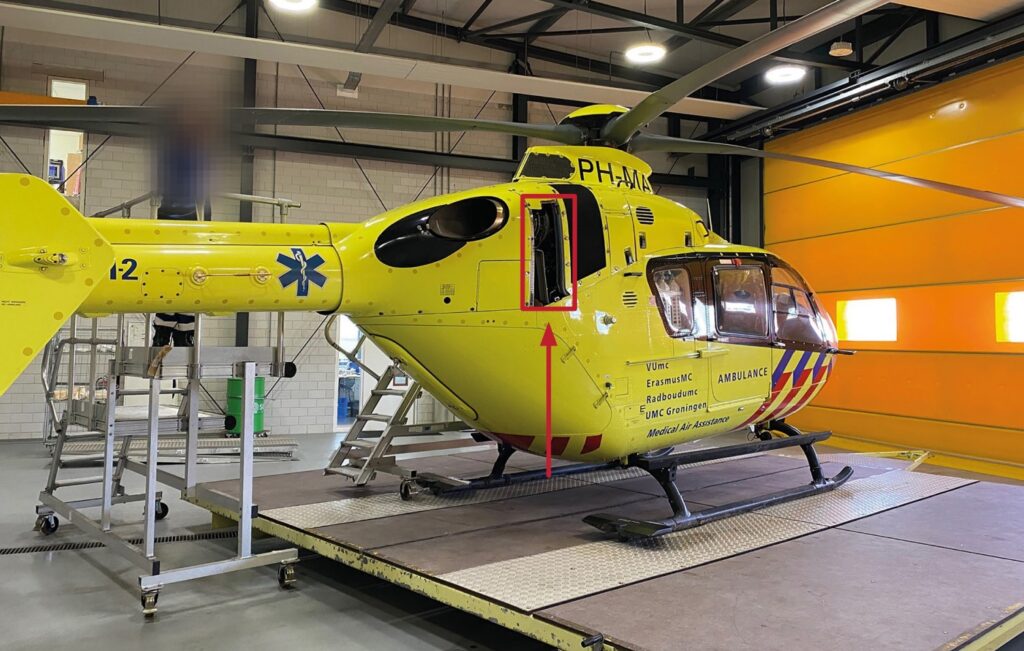Managing Interruptions: HEMS Call-Out During Engine Rinse – Panel Lost (ANWB Airbus EC135T2+ PH-MAA)
On 7 February 2022 air ambulance Airbus Helicopters EC135T2+ PH-MAA of ANWB Medical Air Assistance suffered the in flight loss of an engine inspection panel shortly after departure from Groningen Airport.

ANWB Airbus EC135T2+ PH-MAA at Groningen (Credit: DSB)
According to the Dutch Safety Board (DSB) safety investigation (issued in March 2023), the operator conducts an engine rinse “every 5 flying hours / 3 days, or after flights over sea and/or a polluted environment”. This involves the aircraft commander in the cockpit and a second person operating the necessary ground support equipment. The investigators explain that:
The procedure required the engine cowlings of the EC135T2+ to be opened in order to access the compressor rinse connection and to be closed after the rinsing procedure was completed.
The…procedure also stipulated a plan in case of a Helicopter Emergency Medical Service (HEMS) scramble during the rinsing procedure.
In this case a call-out did indeed interrupted the task. Shortly after take off…
…the pilot heard a noise and suspected the helicopter had struck a bird.
Another ANWB EC135T2+ had indeed suffered a bird strike on 14 January 2021. Investigators note that:
There were no indications or warnings in the cockpit of a helicopter system malfunction and the commander decided to continue the flight.
However shortly after the call out was cancelled anyway and the helicopter proceeded to return to base. Only after landing was an engine inspection panel found to be missing.
The investigators conclude
It is likely that the right engine cowling was not properly closed after the engine compressor rinsing procedure was interrupted by a HEMS scramble. Consequently, as a result of aerodynamic overload, it departed the helicopter during the flight.
Our Observations
It is good that the operator’s engine rinse procedure reportedly considered the task could be interrupted by a call-out.
A lazy analysis would be to simply conclude there was a ‘failure to follow procedures’. That is lazy because:
- the DSB don’t actually describe what was expected in the event of an interruption
- it fails to recognise that by their very nature interruptions and distractions break and disrupt procedural flow.
For this specific task one advantage is that it needs two people, so there are two people who can be used to cross-check key steps to return the aircraft for flight (e.g. disconnecting GSE, securing panels etc).
Safety Resources
The European Safety Promotion Network Rotorcraft (ESPN-R) has a helicopter safety discussion group on LinkedIn. You may also find these Aerossurance articles of interest:
- After Landing this HEMS Helicopter Suddenly Started to Slide Towards it’s Hangar…
- Human Factors of Dash 8 Panel Loss
- EC120 Forgotten Walkaround
- Distracted Dynamic Rollover
- US HEMS EC135P1 Dual Engine Failure: 7 July 2018
- Dusk Duck: Birdstrike During Air Ambulance Flight
- Limitations of See and Avoid: Four Die in HEMS Helicopter / PA-28 Mid Air Collision
- EC135P2 Spatial Disorientation Accident
- HESLO EC135 LOC-I & Water Impact: Hook Confusion after Personnel Change
- Air Ambulance Helicopter Fell From Kathmandu Hospital Helipad (Video)
- Air Ambulance B407 Hospital Helipad Deck Edge Tail Strike During Shallow Approach
- US Air Ambulance Helicopter Hospital Heliport Tail Strike
- Air Methods AS350B3 Air Ambulance Tucson Tail Strike
- NTSB on LA A109S Rooftop Hospital Helipad Landing Accident
- Helicopter Destroyed in Hover Taxi Accident
- Air Ambulance Helicopter Downed by Fencing FOD
- Ambulance / Air Ambulance Collision
- Maintenance Misdiagnosis Precursor to EC135T2 Tail Rotor Control Failure
- Smoke in Cabin: Anatomy of a Wash Rig Error
- Misassembled Anti-Torque Pedals Cause EC135 Accident
- EC130B4 Accident: Incorrect TRDS Bearing Installation
- AAIB Report on Glasgow Police EC135 Clutha Helicopter Accident
- EC135P2+ Loss of NR Control During N2 Adjustment Flight
- Austrian Police EC135P2+ Impacted Glassy Lake
- Loose B-Nut: Accident During Helicopter Maintenance Check Flight
- BEA Point to Inadequate Maintenance Data and Possible Non-Conforming Fasteners in ATR 42 Door Loss
- BA A319 Double Cowling Loss and Fire – AAIB Report
- BA A319 Double Cowling Loss and Fire – AAIB Safety Recommendation Update
- ANSV Report on EasyJet A320 Fan Cowl Door Loss: Maintenance Human Factors
- Tiger A320 Fan Cowl Door Loss & Human Factors: Singapore TSIB Report
- Cessna 208B Collides with C172 after Distraction
- Fatal B206L3 Cell Phone Discount Distracted CFIT
- UPDATE 10 June 2023: EC135 Air Ambulance CFIT when Pilot Distracted Correcting Tech Log Errors
- UPDATE 29 July 2023: Missing Cotter Pin Causes Fatal S-61N Accident
- UPDATE 4 February 2024: HEMS Air Ambulance Landing Site Slide
You might find these safety / human factors resources of interest:
- James Reason’s 12 Principles of Error Management
- Back to the Future: Error Management
- This 2006 review of the book Resilience Engineering by Hollnagel, Woods and Leveson, presented to the RAeS by Aerossurance’s Andy Evans: Resilience Engineering – A Review and this book review of Dekker’s The Field Guide to Understanding Human Error: The Field Guide to Understanding Human Error – A Review
The UK CAA has issued this infographic on distraction:


Recent Comments